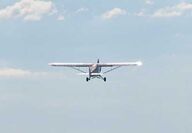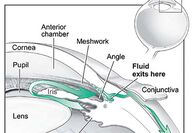Sorted by date Results 51 - 75 of 75

I know you’ll find this hard to believe but diseases sometimes can be fads. In other words some disorders catch the public fancy and all of a sudden “everyone’s got it”. Entities such as Chronic Fatigue Syndrome, fibromyalgia, Lyme’s Disease all are documented illnesses and can be very serious but a lot of people decide they have them because they don’t have any better explanation for their problems. Sad to say, sometimes a health care provider erroneously tags someone with one of these label...

Over the last two months we’ve been talking about the many problems that can pop up when using medicines while flying. Side effects to watch for in the labeling of over-the-counter medications include light-headedness, drowsiness, dizziness and visual disturbance. Allergy, cold and sinus medicines are some of the most common culprits. Be very careful if you are thinking about taking any of those. Prescription medications usually don’t come with a list of side effects so it’s important to ask y...

Last month we covered things to think about before taking a medication and hopping into the cockpit. Medications can cause a world of trouble for a pilot including idiosyncratic reactions and side-effects as well as failure to control the underlying condition for which you’re taking the drug. Light-headedness, drowsiness, dizziness and visual disturbance are the tops of the pops for side-effects that can cause a flight into the glass mountain. So what are some of the drugs to for-sure stay a...

In 2011, the FAA reviewed the toxicology reports of 1,353 recent fatal General Aviation accidents. They found that 42 percent of all pilots involved had drugs in their blood stream that impaired performance. It's a stark reminder that the most common cause of aviation accidents is pilot error, and that a frequent contributor to those errors is drugs, legal or illegal. If you're using crack, ecstasy or heroine, you've got no business going near an aircraft, much less trying to fly it. Now, I'm...

One morning a while ago, a pilot friend awoke and noticed his eyesight was funny. His Venetian blinds looked wavy instead of straight. It seemed that colors weren’t as vivid as they should be. Things seemed a little fuzzy in one eye. He went barreling over to his eye doc and was told he had central serous retinopathy (CSR). This is caused by fluid buildup between the retina and its underlying support on the back of the eye. This leads to a partial a separation of the retina, causing the v...

Question 17b on your FAA MedXpress Form 8500-8 which you fill out before a flight physical, is one that gives folks a hard time: “Item 17b Do You Ever Use Near Vision Contact Lenses While Flying?” Some airmen will say yes if they wear any lenses at all, including eyeglasses. That’s wrong. Some airmen will say yes if they wear any type of contact lens. That’s wrong. Some airmen will say yes if the wear contacts with bifocals. Wrong again! What the FAA is looking for, and wants you to avoid,...

Going to sleep in flight can be a big problem. If you are the Pilot Flying going to sleep is really bad. If you're a long haul relief pilot, not going to sleep can spell trouble. A number of the airline pilots we see have difficulty sleeping in flight on trans-oceanic runs. If you're part of the cockpit crew or flying first class you at least have the option of lying down. That's a big help. Our pilots seem to prefer the newer Boeing 787's or Airbus 380's flight crew rest compartments that provi...

As we get a little older its par for the course to get a little stiff and have a few aches and pains. If you fall into that silver-hair category, try sitting in a GA cockpit for five hours and then spring onto the tarmac. Make sure there’s somebody there to catch you! Sometimes however, those aching joints can get out of hand. Swelling, redness, pain, warmth and loss of function in a joint mean you’ve got arthritis. Arthritis happens frequently and comes in many forms. The most common type is...

It’s been a long time since we’ve talked about the medical issues of high altitude flying. Since then General Aviation pilots have been spending more and more time at higher altitudes. The ubiquity of turbocharged single-engine GA craft has made it easy to crank an unpressurized cabin up to the flight levels and get that big tailwind. Before you do that though, make sure you have the right equipment for supplemental oxygen delivery and know how to use it! Your risks of oxygen starvation or hyp...

Communication is critical when flying, especially IFR. I was reminded of that a few years ago when we were in the clag, out of Atlanta, Minnesota bound. George was doing most of the flying and things were pretty calm until Atlanta Center issued the somewhat mush-mouthed call: “Two Nyna Fav Delta Lima, fla daarek sea two.” At least that’s what I thought I heard. After a couple of back and forth’s with our heavily accented controller, it was finally discovered that we should fly direct to the Cha...

Have you ever thought that flinging yourself through the air at several hundred miles an hour, several miles above the earth in a tiny cylinder of aluminum is a bit odd? Probably not. You're a pilot and flying is the best thing conceivable. However, your body may not agree with you. Even in the most modern of commercial aircraft, the environment is not what you normally experience on your front porch. The cabin altitude is usually around 8,000 ft. MSL, a big jump for us Midwesterners. Oxygen...

Not too long ago a pilot friend wandered into the clinic looking pretty rugged. His appetite was bad. He'd been losing weight. Felt tired all the time. He really got alarmed when he noticed his eyes turning yellow and his legs swelling. He was feeling a little confused at times. He was worried. We did a few blood tests that confirmed what I was suspecting-hepatitis, an inflammation of the liver. In this case it was due to Hepatitis C virus. Hepatitis C Virus, HCV or Hep C as it's often called, i...

A couple of years ago, one of our pilots strolled off the tarmac and ducked behind a tree to relieve himself. Much to his horror he produced a bright red urine stream. He had previously felt great. He had no pain. It was a bolt out of the blue. I promptly received a call from a very agitated airman and arranged for him to see the appropriate specialist pronto. An expedited visit to the urologist revealed that he was one of some 68,000 adults in the United States who are diagnosed with bladder...

Well, it's still winter in Minnesota. Last month we talked about cold injury and how to avoid it while pre-flighting and operating your aircraft in a Northern winter. Now let's look at how to stay alive just in case you missed something in your preflight and had to make a forced landing. If you had to put her in a field in Southern Minnesota, it's probably no more than a half mile walk to the nearest farm house. If you're north of Hinckley or flying out west however, it is probably not going to...

If you've looked out the window recently, you've probably noticed its winter in Minnesota. Thus, it's time to talk about how you can easily loose bits and pieces of your anatomy on the tarmac if you are not respectful of the cold. Not all of us have the luxury of a heated hangar. When we're flying cross-country in winter, it usually means doing some pre-flights on a windy, frigid stretch of concrete. That's an ideal set-up for freezing some part of you-Frostbite! The mildest form of Frost Bite...

I don't know about you but that kind of call from ATC always gives me the willies. Someone is buzzing around out there. They don't have enough sense to turn on their transponder, if they have one, and I'm not picking them up with my peripheral vision. It makes you realize how difficult "See and Avoid" really is. Imagine how much more so that would be if hunks of your peripheral vision were gone. That's what happens in early glaucoma. That's why the FAA is really concerned if you have it....

Back in March of 2013, the FAA started defining “Conditions AMEs Can Issue (CACI).” They realized that many uncomplicated illnesses that had required a decision by the FAA in Oklahoma City could be monitored by a local Aviation Medical Examiner (AME). It’s been nearly five years since the FAA started granting this discretion to AMEs and it seems to have worked out well. There has been no increase in accidents attributed to this delegation of oversight and life has become a lot easier for pilot...

March 29 this year, a Boeing 737-300 (AA 1353) was on short final heading into KABQ down in Albuquerque when the First Officer suddenly slumped forward, unconscious. Fortunately, the Captain noticed, summoned paramedics, and landed the plane safely. Attempts to revive the First Officer were unsuccessful, the presumed cause of death being a heart attack. Fortunately, life-threatening incapacitation of pilots in a commercial setting is rare. Even more rare is the flight's safety being...

General aviation is great. You can jump in your airplane (after appropriate and exhaustive pre-flight planning, of course), point her in any direction you please and buzz along for as long as winds, weather, avgas and ATC allow. What's not so great is that very few of our aircraft have rest rooms. I have yet to see a C-172 with a loo. I know you can buy nifty little plastic bags filled with super absorbent gunk from Sporty's. Of course there is always the old milk bottle. I have yet to convince...

A little while ago an airman came in with a set of chest muscles that made him look not so much like Superman as a tom turkey. He was quite muscular all over. It was obvious that he'd been working out. Really? To get to the point where you look like a super-hero action figure? Talking with him, I found out he'd been diagnosed with low testosterone or "Low T" as they say in the TV ads. He'd been using hormone patches, although I thought he might have been going at it a little more than his doc...

It's been almost five years since we talked about sleep apnea (September, 2011) and the FAA's approach to this problem has been updated. Obstructive sleep apnea (OSA) is very common. .It affects anywhere from 9% to 28% of adults. It happens when the upper airway becomes obstructed during sleep causing disruption of normal sleep patterns. It is usually caused by overweight. Fat tissue in the neck can block the airway, causing an interruption of air flow. It seems to occur more commonly in men...

Our cousin had a dark black spot on her lower leg for a couple of years. Her local doc told her not to worry. It got bigger. She let it slide for a few months as she and her husband were moving up here to The Cities. I got her in to a dermatologist who biopsied it and confirmed what we both were thinking and dreading-malignant melanoma. It had spread throughout her body. She was dead six months later. Unfortunately, this tragic story is a common one. The incidence of this form of skin cancer...

Over the last two months we've covered the basics of BasicMed, an alternative to the Third Class Medical for flying legally. We've talked about what kind of flying you can and can't do under BasicMed; what you have to do to qualify under BasicMed; who is better off using BasicMed or a traditional Third Class Medical. Just in case you've missed them you can read the last two articles on the Minnesota Flyer web site. So let's say you've decided BasicMed is right for you. Just like the Third Class...

Last month we took a look at some of the provisions of BasicMed, a new way to legally fly without a Third Class Medical Certificate. We talked about the restrictions on aircraft type and operation as well as the basic procedures a pilot will have to follow if she/he elects to go this route to establish medical qualification. Bottom line-if you are a healthy person under the age of forty, it's probably easier and more cost effective to stick with the traditional Third Class Medical. If, however,...

Last month we took a look at some of the provisions of BasicMed, a new way to legally fly without a Third Class Medical Certificate. We talked about the restrictions on aircraft type and operation as well as the basic procedures a pilot will have to follow if she/he elects to go this route to establish medical qualification. Bottom line—if you are a healthy person under the age of forty, it’s probably easier and more cost effective to stick with the traditional Third Class Medical. If, how...